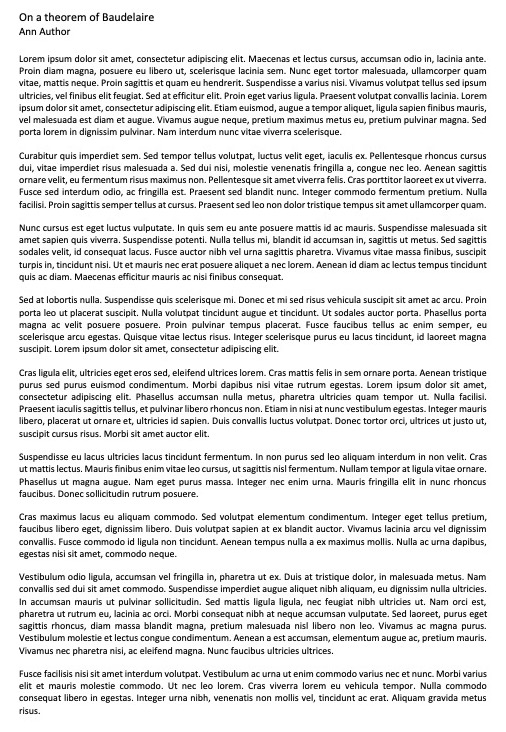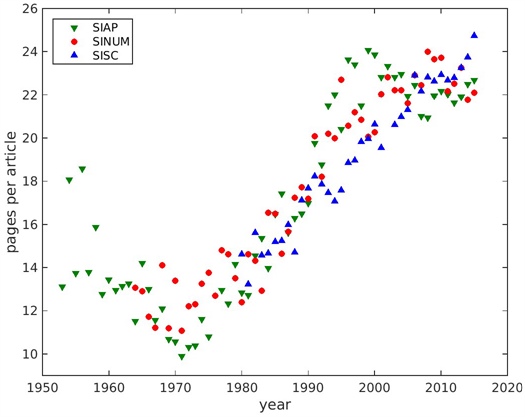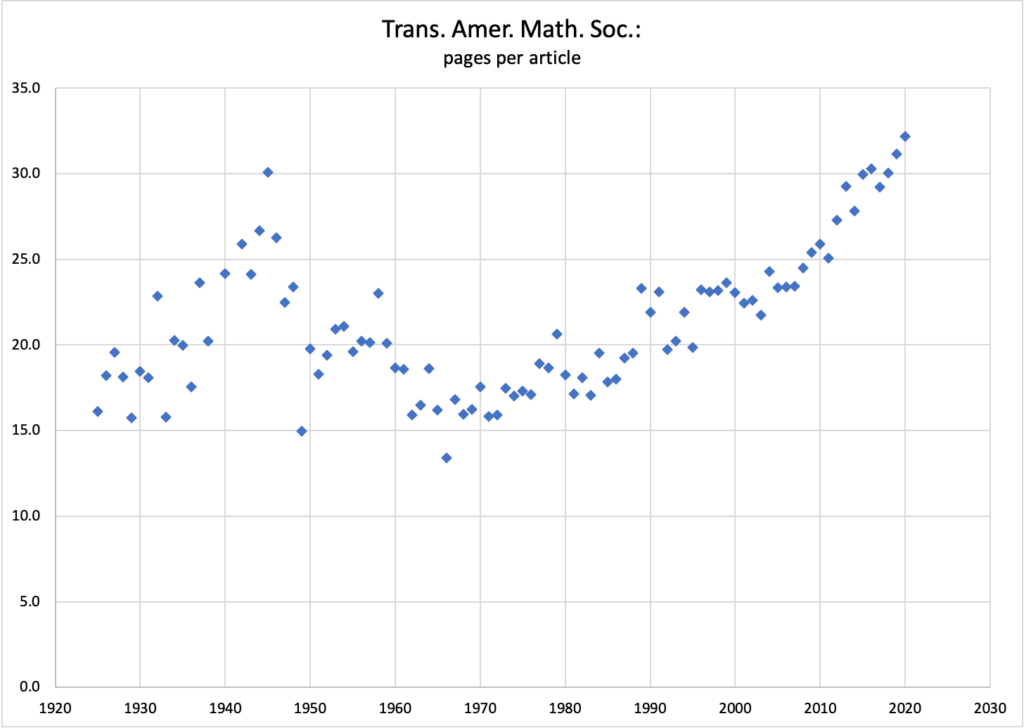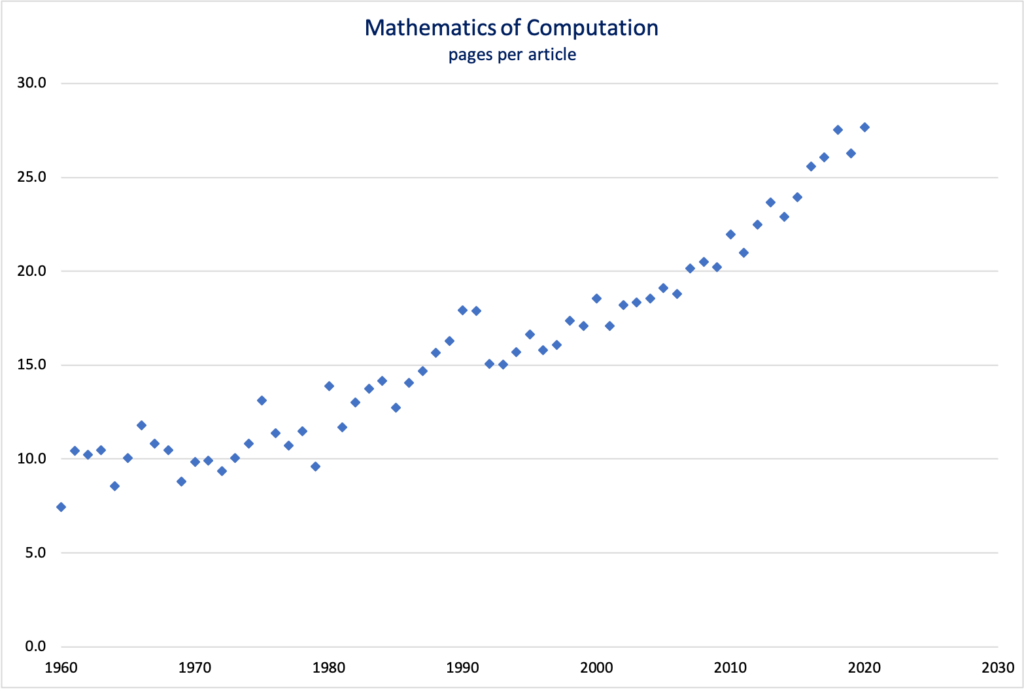 At the September 2021 meeting of the AMS Committee on Publications, Nick Trefethen asked whether Mathematical Reviews has seen an increase in the average length of papers that come through for indexing in MathSciNet. I had not thought about that question, and there isn’t an easy query for page length in the Math Reviews database. During the overnight break, I looked into the data for Transactions of the American Mathematical Society. Afterwards, I looked at two more journals, Mathematics of Computation and Annals of Mathematics.
At the September 2021 meeting of the AMS Committee on Publications, Nick Trefethen asked whether Mathematical Reviews has seen an increase in the average length of papers that come through for indexing in MathSciNet. I had not thought about that question, and there isn’t an easy query for page length in the Math Reviews database. During the overnight break, I looked into the data for Transactions of the American Mathematical Society. Afterwards, I looked at two more journals, Mathematics of Computation and Annals of Mathematics.
This was not a random question on Trefethen’s part, he had written a letter to the editor of SIAM News on the topic, which was published in the July/August 2015 issue. The letter was based on data collected by members of the Numerical Analysis Group at Oxford, of which Trefethen is the head. The average length of papers in the three SIAM journals SIAM Journal on Applied Mathematics (SIAP), SIAM Journal on Numerical Analysis (SINUM), and SIAM Journal on Scientific Computing (SISC) had doubled from 1975 to 2020.

Average pages per article of three SIAM journals. Image from: Trefethen, Nick, Letter to the Editor: Why Have SIAM Journal Papers Grown So Long? SIAM News, Volume 48, Number 6, July / August 2015, p 2. https://sinews.siam.org/Details-Page/letter-to-the-editor-why-have-siam-journal-papers-grown-so-long.
There is more on this topic on Trefethen’s blog, such as here.
The data for the Transactions of the AMS produce a graph very similar to the graphs for the SIAM journals, at least after things stabilized in the 1960s.
 The average number of pages in the years from 1965 to 1969 ranges from 13.5 to 16.8. In the most recent five-year period, the average number of pages ranges from 28.8 to 31.7.
The average number of pages in the years from 1965 to 1969 ranges from 13.5 to 16.8. In the most recent five-year period, the average number of pages ranges from 28.8 to 31.7.
We can compute the average number of pages per article by decade, as in the following table, which shows that the average length of an article in Transactions has indeed doubled since the 1960s.
| Transactions of the AMS | |||
| Decade | #pgs | #articles | pgs/art |
| 1920 | 4004 | 229 | 17.5 |
| 1930 | 8891 | 459 | 19.4 |
| 1940 | 9785 | 416 | 23.5 |
| 1950 | 14741 | 724 | 20.4 |
| 1960 | 28556 | 1735 | 16.5 |
| 1970 | 49678 | 2852 | 17.4 |
| 1980 | 46821 | 2500 | 18.7 |
| 1990 | 52421 | 2398 | 21.9 |
| 2000 | 56825 | 2422 | 23.5 |
| 2010 | 87778 | 3034 | 28.9 |
| 2020 | 9007 | 280 | 32.2 |
It is tempting to consider the question for the Proceedings of the AMS, but it has a page limit. Assuming that the upper bound is mostly obeyed, it is unlikely that we will see the phenomenon in the Proceedings. I am not aware of any strict page limit for the AMS journal Mathematics of Computation, however. Let’s check it out. Here is the plot for Math. of Comp. from 1960 to 2020:

Visually, the growth is rather clear. As before, we can compute the average number of pages per article by decade, as in the following table:
| Mathematics of Computation | |||
| Decade | #pgs | #articles | pgs/art |
| 1960 | 6600 | 683 | 9.7 |
| 1970 | 11165 | 1092 | 10.2 |
| 1980 | 14412 | 1062 | 13.6 |
| 1990 | 17626 | 1082 | 16.3 |
| 2000 | 20883 | 1107 | 18.9 |
| 2010 | 28274 | 1180 | 24.0 |
| 2020 | 3071 | 111 | 27.7 |
As with the SIAM journals, the Transactions of the AMS and Mathematics of Computation has also seen the average length of an article at least double since the 1960s.
What about Annals of Mathematics? Well, here is the plot of the data for Annals:

For the Annals, the size of the articles prior to 1965 did not vary as much as we saw for Transactions. Again, the growth is quite visible from the plot. The table of the data for the Annals by decade shows consistent growth in the length of articles:
| Annals of Mathematics | |||
| Decade | #pgs | #articles | pgs/art |
| 1930 | 8924 | 600 | 14.9 |
| 1940 | 9223 | 555 | 16.6 |
| 1950 | 12517 | 717 | 17.5 |
| 1960 | 12032 | 528 | 22.8 |
| 1970 | 11976 | 452 | 26.5 |
| 1980 | 12761 | 417 | 30.6 |
| 1990 | 14857 | 398 | 37.3 |
| 2000 | 22208 | 537 | 41.4 |
| 2010 | 27473 | 565 | 48.6 |
| 2020 | 3666 | 62 | 59.1 |
Going by decades, the average length of an article has more than doubled from the 1960s to the present.
So what is going on? There were no definitive answers during the discussion at the Committee on Publications meeting. In his letter to SIAM News, Trefethen suggested that this is an indication of the professionalization of mathematics. That is to say, 45 years ago, it was OK to write a paper that just presented an idea. Now, an article represents a “piece of work”, explaining connections with other work. The good thing about a piece of work is that it is less important for you to be part of the in-crowd to understand the paper. The bad thing about a piece of work is that, in our time-crunched lives, we are more likely just to skim it, rather than to read it fully.
The phenomenon is curious, though, because it contradicts the supposed trend of “salami slicing” your work into several articles rather than one big article, aiming for the LPU (“Least Publishable Unit” or “publon”). On the other hand, these six journals are not necessarily typical.
Acknowledgments
I am grateful to Nick Trefethen for asking the question, then encouraging my exploration of a very partial answer to it. Thank you, also, to SIAM and SIAM News for so readily granting permission to reprint Trefethen’s original plot.

Edward, appreciate these observations, but I’m thinking that publishers as well as editors in the recent past have forgone page length as a limiter or filter on publishing good math of just even ideas. With manuscripts turned to PDFs and web documents they are exclusively ‘born digital’ and most often never see print paper. Without considerations for online or digital journal edition paper equivalents, page length and even journal editions and journals themselves are quickly going away as publishers, editors, researchers and librarians pivot to this new normal. One day students will wonder “What’s with article page length?” akin to the disappearance of print journals, books and maybe paper and pencils. Ian D. Gordon
Have you tried to look at number of pages divided by number of authors? The number of authors has been growing as well and that might be the explanation.
The salami-slicing is easily explained; looking at journals with a long history and high prestige cannot take into account compositional effects like the efflorescence of paper mills and low-quality journals. That is, you cannot salami-slice the most prestigious journals because they will simply reject that and focus on quality and defensibility (as they can easily do given the overall growth while they remain the same size and publish fewer papers, if anything), which increasingly selects for long papers – while the slices go to all the other journals, particularly new ones. You’d need some field-wide metric (which of course brings in its own problems compared to a tight precise focus on a few old journals).
I am also a bit skeptical that technological changes like TeX or digital publications really changed much for these journals. This is a smooth trend over a long time, with no particular bumps corresponding to the introduction of useful TeX ~1980, or PDFs+WWW ~1995. Were journals really discontinuing paper publication rapidly in, say, 1970?